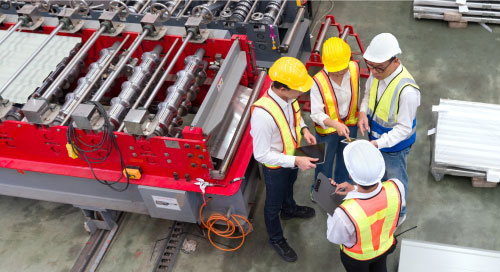Fill form to unlock content
Error - something went wrong!
Your content is just a step away. Please submit below.
Thank you!
Fast-Track Your Industrial Digital Transformation

In a volatile and highly competitive global market, digital transformation is the holy grail for industrial organizations. To gain an edge, manufacturers deploy the latest Industry 4.0 technologies like AI and computer vision to become more agile, reduce operating costs, secure their business, and grow revenue.
But this path toward industrial digital transformation comes with many hurdles: an aging workforce and skills gap, growing cybersecurity risks, OT and IT silos, and the complexities of harnessing widespread data. Business leaders are tasked with figuring out how they can leverage the technology and overcome these challenges—and where they should even begin. Engaging with a partner like global technology solution provider World Wide Technology (WWT)—with its deep expertise in both industrial markets and technologies—is a great place to start.
“We can work with clients to find and identify the quantitative and qualitative digital transformation challenges that are impacting their businesses. We look at the biggest opportunities to mitigate risk, decrease costs, increase margins, and grow revenue,” says Mike Trojecki, Senior Director, AI Practice at WWT.
Industrial #DigitalTransformation is more than just deploying #technologies like #AI and #ComputerVision. You must address internal cultural issues as well. @wwt_inc via @insightdottech
According to Trojecki, industrial digital transformation is more than just deploying technologies like AI and computer vision. You must address internal cultural issues as well. “It’s the age-old question of IT looking at the OT people and thinking that they don’t understand the technology challenges from an IT standpoint,” he explains. “And then you have the OT people who look at IT as an inhibitor to getting their work done.”
With WWT’s 30+ year history in both on-the-floor plant experience and working with IT organizations, the company can not only help companies overcome challenges but also serve as a conduit between IT and OT, helping companies bridge that gap. It may be as simple as an educational undertaking or a full end-to-end POC to take the necessary steps in moving from point A to point B.
Overcome Business Challenges with Industry 4.0 Technologies
When WWT looks at a client’s overall processes, it can map the technologies and solutions that solve key business challenges.
For example, a common dilemma industrial organizations face is keeping workers safe on the plant floor. “When you look at computer vision, it’s not just about defect inspection and detection,” Trojecki says. “It’s also technology for keeping people safe and secure. If someone places themselves in a situation where they could be injured, AI and computer vision can recognize the safety issue and potentially take action to prevent an injury or even a fatality.”
WWT also uses AI and other Industry 4.0 technologies to power digital twinning, which is essential to the manufacturing landscape for use cases from virtually testing products to digitization of a factory, and even running a process through a virtual environment. There’s a lot of value that can be brought in using digital twins, and Trojecki says WWT is doing so with customers in plants, distribution centers, and data centers.
“You can create a digital representation of a new product before it goes into a manufacturing line, and even prove out a process change without having to do so physically,” says Trojecki. “A digital simulation of the physical and process world gives operational and IT teams a better shot at success with less risk and at a lower cost.”
Predictive Maintenance Lowers Operating Costs
Implementing predictive maintenance solutions across plant floors is another example of how WWT helps its clients modernize manufacturing processes and reduce operating costs. Traditionally, predictive maintenance has been the domain of factory line workers with years of experience, with the know-how to detect machine anomalies through abnormal vibrations or noise and interpret pending problems.
As this generation of workers retires, companies are transitioning to a data analytics model that is more cost-effective but requires a whole new set of skills. WWT’s experience in bringing OT and IT together, training a new generation of workers, and deploying complex AI solutions pays off.
For example, WWT worked with a machine manufacturer that needed to minimize equipment downtime. The company’s ultimate goal was to reduce errors and quality deterioration in the manufacturing process. A predictive maintenance solution—using sensor data and computer vision—was deployed to analyze machine health and take action before there was a problem, which helped to reduce overall machine maintenance and support costs.
WWT partnered with software and hardware providers to develop a complete solution that empowers the client to look into the manufacturing process, change the control network, and fix problems on the fly, instead of pulling systems offline. The solution increases machine utilization and saves the company from having to reevaluate an entire manufacturing line. Now the customer can keep machines in service longer, reduce downtime, and lower the cost of getting product out the door.
Close collaboration with solution providers is essential to WWT’s business and customer success. Intel and its extensive partner ecosystem enable WWT to select and implement the right product mix that best solves specific digital transformation challenges.
And it’s a two-way street. “We align with our partners from a technical standpoint and a solution development standpoint,” says Trojecki. “We can’t do it without them. And to be honest, on the other side, they can’t do it without us.”
Industrial Digital Transformation Expertise Leads to Business Success
As company stakeholders look at new opportunities, AI has become the number-one driver in most conversations. “Clients are asking, ‘How is AI going to affect what we’re doing in the plant?’ ‘How will it play in our overall industrial operations?’” says Trojecki. “Businesses need to start somewhere and those that don’t embrace emerging technologies will quickly fall behind.”
Across the globe, WWT is well positioned to help organizations succeed in achieving their transformation goals.
This article was edited by Christina Cardoza, Editorial Director for insight.tech.